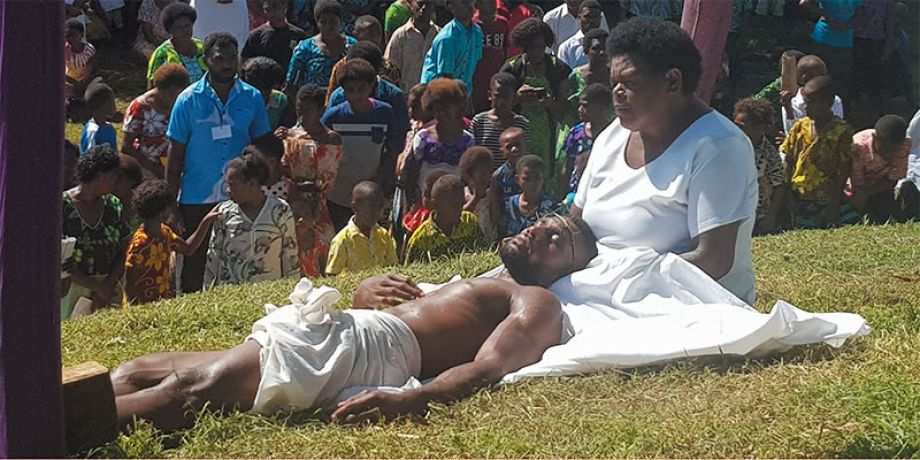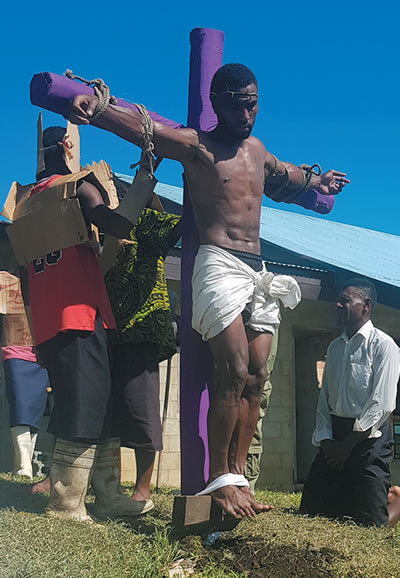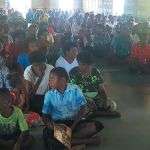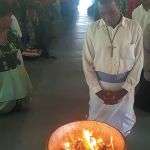
It has always struck me that the Fijian translation of Good Friday is simply and literally, “Day of Death.” No massaging, no theological euphemisms, just saying is “as it is.” In turn, preparations for this day are taken very seriously, and the crosswalks or the dramas with which they mark the day are often long, physically challenging, and emotional.

Such was the case with the five “highland” villages of Ba today, where 40 of whose youth had started carrying the cross in silence on Wednesday morning along the almost 20-mile stretch on the tough and parched roads linking their villages. They were accompanied by the parish catechists of each village (and often by youth of other Christian denominations) who gave teachings each night on the meaning of Holy Week.
Having bid goodbye to the parishioners of Ba Town at 6 a.m. as they boarded a bus to begin their own cross walk, and knowing that the other section of the parish (the four coastal villages) had also been on the road since 5 a.m., I headed up the hills to Navala, to first conduct five baptisms and the admission of twelve young people into our Sacrament of Confirmation Program.
By 9 a.m., we were ready to witness the highland youths’ rendering of the Passion of St. John, which was interwoven with the fourteen traditional Stations of the Cross. The lifelike shouts of the soldiers and physical mistreatment of Jesus abruptly brought us back to that day in Jerusalem some 2000 years ago.
Dressed in uniforms culled from cardboard boxes, except for the few wearing Fiji army fatigues, they pushed Jesus up the hill of the village, where he met his mother and the weeping women, fell and stood up again three times, was helped briefly by Simon of Cyrene, and was finally divested of his clothes right down to his undergarment, at which point he was hoisted over the village on a cross.
At one point, I had to make sure that the nail hammering was not an actual crucifixion, but a way of squeezing his legs between two narrow slats, which is of course very painful. After death, he was taken down from the Cross into the arms of his mother after which the soldiers carried him into the sacristy for burial.
Rather than all adjourn to wait for the liturgical 3 p.m. Service of the Passion, I asked that we keep going. In place of individual confessions, a service of communal repentance was led by the catechists, with villages having written down their sins, seeing them go up in flames before the altar.
The Liturgy of the Word followed, and I also decided to let the youth who had learned their parts by heart in their drama also conduct the proclamation of the Gospel — the same Jesus, Peter, Pilate, crowd, etc. This was a powerful “retake” of what we had already seen, my homily noting that while the Stations of the Cross (and the other three Gospel writers) emphasizes Jesus’ physical suffering on Good Friday, the Gospel of John rather poses a number of awkward questions to us such as Who is Jesus for you?; Do you (like Peter and the others) also deny knowing him when the chips are down?; Who is really on trial here — Jesus, Pilate or you?; What king (meaning power structure) do you choose in your life? Is it that based on violence, patronage and the size of one’s army, or it one whose only weapons are integrity and truth?’
The same youth then held up two crosses for the rite of veneration, and we ended with Communion being brought up (and returned) to the house in the village where it had “slept” last night.
After the Liturgy, we retired for the drinking of kava which lasted until exactly 3 p.m., at which time the village fell silent to mark the hour of Jesus’ death. We then had lunch and I left.
I will say that this “Day of the Dead,” this “Good Day” will remain in my memory for many days, and I continue to marvel at the ingenuity of the Fijian people, particularly the young people, in their taking this story to themselves and presenting in a way that shakes one’s liturgical niceties, returning it to the physical, messy and ultimately loving day that it was.
Fr. Patrick Colgan lives and works in Fiji.




